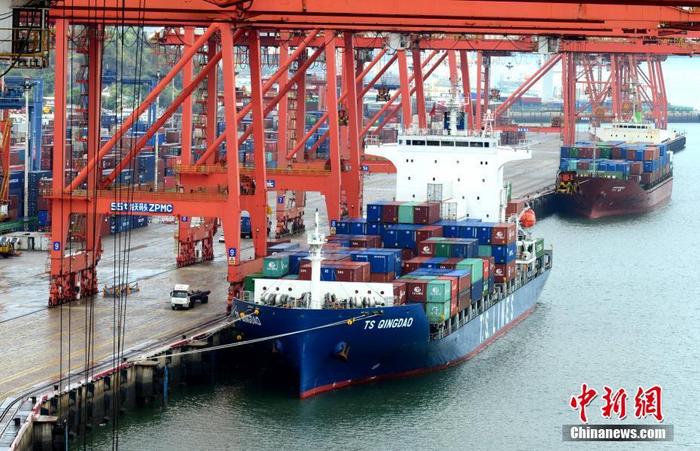(Economic Observation) China has become the "big locomotive" of global trade recovery?
China News Service, Beijing, April 22 (Reporter Li Xiaoyu) China has increasingly become an important force in promoting the recovery of global trade, and many countries have benefited from China's strong demand.
According to the latest official data from Japan, the country’s exports in March this year increased by 16.1% year-on-year, marking the first increase in two months.
Among them, exports to China increased by 37.2%, reaching 1.63 trillion yen.
This is the ninth consecutive month of growth in Japan’s exports to China.
The data picture shows the Haitian Container Terminal of Xiamen Port.
Photo by China News Agency reporter Wang Dongming
According to the Nihon Keizai Shimbun, the 2020 trade statistics flash report shows that the Japanese economy's dependence on the Chinese market is increasing.
Exports to China accounted for 22.9% of Japan's total exports, a record high in the past ten years.
China has surpassed the United States to become Japan's largest export market.
Also benefiting from strong Chinese demand, Singapore's exports in March increased by more than 12% year-on-year.
Official data show that Singapore’s exports to China increased by nearly 50% that month.
China surpassed the United States for the first time last year and became the EU's largest trading partner.
It is beneficial to China to become a powerful engine that stimulates the growth of exports from other countries.
In the words of Liang Ming, director of the Foreign Trade Research Institute of the Institute of International Trade and Economic Cooperation of the Ministry of Commerce, China's position in the global market structure has further improved after the outbreak, and foreign trade has successfully "turned crises into opportunities."
This is mainly due to the continuous acceleration of China's economic recovery and the continuous expansion of the domestic market.
In the first quarter of this year, China's GDP growth rate soared to 18.3% year-on-year, and consumption growth rate was as high as 33.9%. Demand that was once suppressed by the epidemic is gradually releasing.
In addition, the manufacturing purchasing managers' index has been on the line of prosperity and decline for 13 consecutive months. The production index and new order index of most industries are above the threshold, which has led to a significant increase in the import of integrated circuits, energy resources and other products.
China's active import expansion policy is also one of the reasons.
According to China Customs data, as of the end of last year, China's import customs clearance time has fallen to less than 35 hours, a reduction of more than 60% in three years; the regulatory documents that need to be verified in the import and export process have also been reduced by more than half compared with 2018.
Measures such as the establishment of fast passages for Chinese and foreign personnel exchanges and "green passages" for material transportation have also facilitated the increase in imports.
Considering that China’s economy is still recovering steadily, and the government is preparing more consumption promotion policies and measures to promote consumption to return to pre-epidemic levels as soon as possible, China’s import scale will continue to grow in the future, and its boost to Asia-Pacific and global trade will also be even greater. Significantly.
Zhao Ping, vice president of the China Council for the Promotion of International Trade Research Institute, told reporters that China's economy has now entered a normalized growth track, and the economy as a whole is expanding. It is expected that the scale of imports and exports will continue to expand in the future.
However, some analysts believe that with the strong recovery of the US economy, North America may become the "main force" driving trade growth in the future.
The latest report of the World Trade Organization (WTO) predicts that from the perspective of demand, due to the continued increase in the US fiscal stimulus, imports of North American goods are expected to increase by 11.4% in 2021, which will become the main region that stimulates global demand for trade in goods and stimulates trade and economy in other regions. increase.
Zhu Haibin, chief economist at JPMorgan Chase China, also said that under the strong stimulus policy of the Biden administration of US$1.9 trillion, the US economy will grow significantly faster than China in the second and third quarters of this year, which is significantly different from last year.
Under this circumstance, the main driving force for the global economic and trade recovery this year may be provided by the United States.
However, according to Zhang Ming, deputy director of the Institute of Finance of the Chinese Academy of Social Sciences, the US economic recovery is currently unstable and uneven, and the labor market is still facing major problems.
At present, US consumption is largely stimulated by fiscal stimulus. Once the fiscal stimulus ends, consumption will also decline, and the prospects for economic growth are still uncertain.
(Finish)

